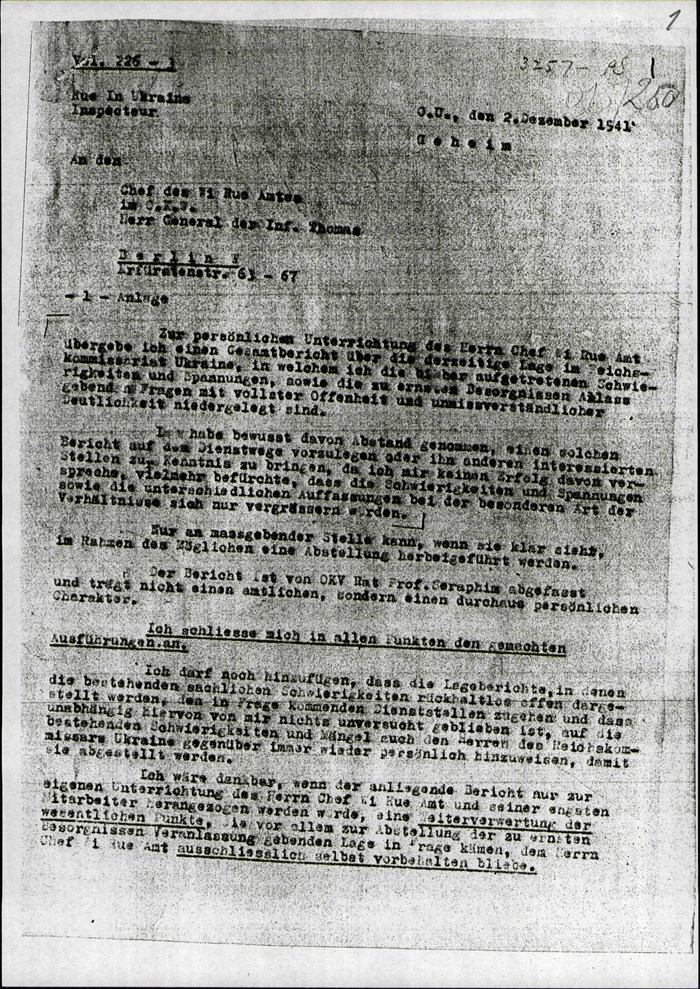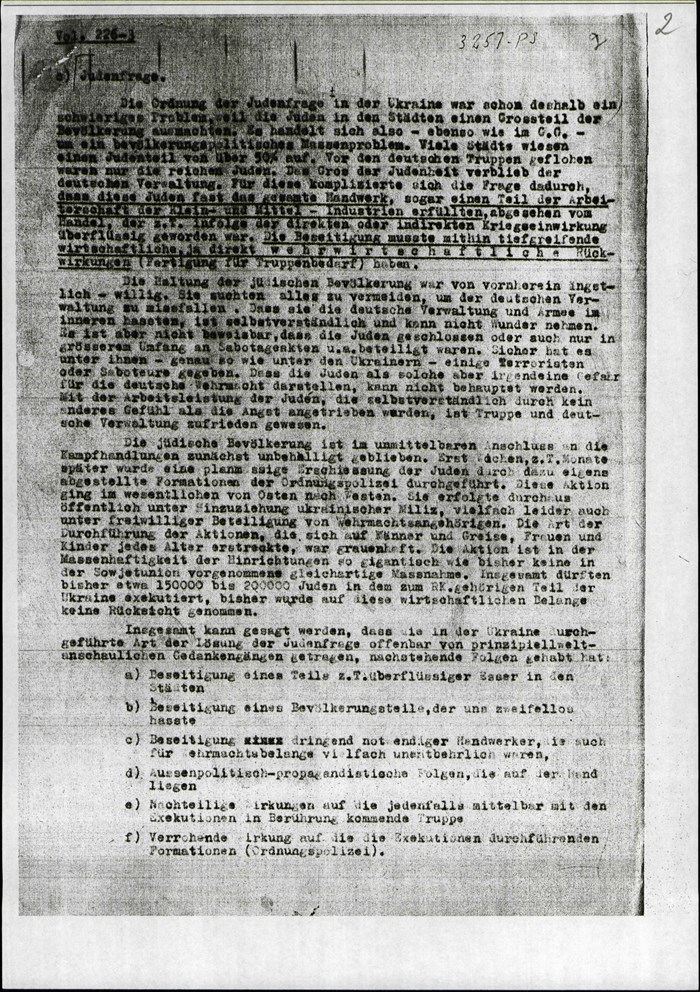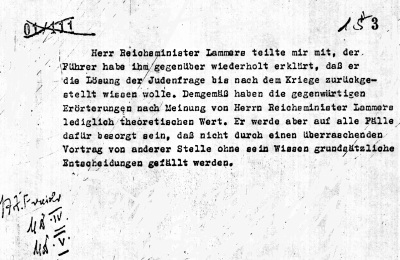gl0spana wrote:HMS, Lamprecht:
documents 3, 8, 9, 13, 14, 19, 20 are not part of the einsatzgruppen reports and have not been debunked or even explained by revisionists
I share your sentiment that some of these document's haven't been dealt with more in depth, but one must wonder why? Do they change very much? For someone like Mattogno not to address them, even though he cites the sources used by the HC bloggers indicates to me that they're not very important. Especially since he already deals with the death toll in the book, why spend time detailing the reliability of every single document that crosses your path that for one reason or another might be banal to the experienced researched. To you or I Gl0spana a document may seem more incriminating that it actually is because we lack the experience with the physical documentation.
You also do not know whether these documents have been dealt with in other areas of the book, it won't just come up by searching specifics. It might only be in passing. Regarding the USSR documents, they would be easy to miss because in the Holocaust Handbooks they're not cited in the same way, so clues from the text itself had to be searched to find a reference, and I did find those references albeit sparse for my liking but still useful.
For example, document 3 is dealt with, but it's not cited in the same way:
But the matter becomes even more confusing when one reads Dina Pronicheva’s account in Wiehn’s opus. Significant differences in her recorded statement at the Darmstadt Trial are added in parentheses, with the note S:“On September 28, 1941, an order from the German authorities was posted throughout the city […] about 8 o’clock in the morning [S: at 8 o’clock] near Dyekhtyarevska and Melnik Streets [S: Dyakhterovskaya and Melnikov]. . .
Germar Rudolf (editor.), Dissecting the Holocaust (Castle Hill Publishers, November 2019), Pp. 519.
Document 8 I have inadvertently dealt with in this thread already. It claims there were 400,000 Jews in Kiev! A ridiculous number, an impossible number, as has been proven already and again is a discrepancy between Incident Report 106 and 97. The document is not incriminating, it's used only to provide figures for the Jews supposedly in the area. Document 9 was quoted in full by Mattogno on page 527 of 'Einsatzgruppen', and the contents mentioned on page 509 of 'Dissecing the Holocaust' although the document itself was not cited. Document 13 is addressed on page 511 in Mattogno, but only in passing because it's another document claiming that 35-40,000 Jews were killed, the veracity of this number itself gets the full attention of revisionists which is what's important; the number is untenable. Document 19 I can't find an explicit reference to, but you can search the Handbooks for the numbers cited, Terry and a number of 42,000 is addressed if you simply search volume 28 of the Holocaust Handbooks, although it may not be a reference to the same document. Document 20 is yet another document like that of no. 13. You can find references to Martin Luther though, some rather contradictory:
In the January 26, 1942, letter from the Chief of the Security Police and the Security Service (Heydrich) to Under Secretary of State Martin Luther in the Foreign Office, we read:“Now that the fundamental line to be taken with regard to the practical final solution of the Jewish question has been determined and the authorities involved are in complete agreement, I would ask you […]”
and farther down:“[…] to assign your official in charge of completing the outline requested by the Reich Marshal, in which the organizational, factual and material prerequisites for the practical implementation of the tasks involved in the solution are to be identified, to the required discussions of specific details. I intend to hold the first discussion of this kind on March 6, 1942 […].”
In other words, considerations of all the organizational, factual and material prerequisites for a practical implementation of the tasks involved in the solution were not even begun until about mid-March 1942.
Germar Rudolf (editor.), Dissecting the Holocaust (Castle Hill Publishers, November 2019), Pp. 533.
This is certainly odd considering the 'extermination of the Jews' is said to have already been well under way!
The fact remains, the majority of these documents have been addressed to varying degrees, you just haven't done your due diligence Gl0spana. I was able to find these references in less than an hour.
It should also be noted that it's tough to say whether any or all of these documents may have been addressed in other languages. For example, the study by Udo Walendy.
gl0spana wrote:14 in particular describes the Jews getting tricked into believing in their resettlement and then being indiscriminately killed in a slaughter so ghastly in order to do it the executioners had to be numb with alcohol. Do you believe this happened?"It is ordered that the Jews are to be "resettled". This is done in such a way that the Jews are ordered to gather in the following night with their best clothes and jewlry at collection places. No difference is made between classes, sex and age. They are then brought to a previously selected site outside the town. On the pretext that certain formalities are still to be fulfilled, they have to put aside their jewlry and clothes. They are taken off side the street and liquidated. The resulting situations are so shocking that they can not be described. The consequences for the German commandos are inevitable. In general, the execution can only be carried out under numbness with alcohol. A SD officer ordered to watch had to endure a nightmare of the most dreadful kind the following night according to his description."
And yet we have many documents attesting to the contrary. I suggest you read the chapter on 'resettlement' in Holocaust Handbook volume 28, which I linked to you above. This document also doesn't change the fact that "resettlement" was not a code word, you can read about this again, in Mattognos Einsatzgruppen to get a more nuanced view of how the word was used. For example:
“Umsiedlung” is sometimes clearly used as a synonym for execution, while on other occasions it means what it translates to: resettlement; in some cases it seems to be distinct from execution, as in this example:“As a result of the measures taken by Einsatzkommando 6, the towns of Gorlovka and Makeyevka are now free of Jews. Some of them, remaining in Stalino, will be resettled as soon as the weather permits it. A total of 493 persons were executed here (including 80 political activists, 44 saboteurs and looters and 369 Jews).”
Here, by contrast, we appear to have the inexplicable use of the “camouflage” term “resettled” and the undisguised word “executed” in the same context.
Carlo Mattogno, The Einsatzgruppen in the Occupied Eastern Territories: Genesis, Missions and Actions (Castle Hill Publishers, December 2018), Pp. 66.
I would still like to see Mattogno address the document allegedly written by Erwin Stolze (document 14) more thoroughly.
gl0spana wrote:How many of the above documents do you think have been fabricated in whole or part? The Germans were "bragging" about killing 30,000 people in two days?. Extrapolate that over 4 years and you get 18 million people
We cannot say, we can however say that the figures are inaccurate, which has been proven, and not simply by the lack of remains as revisionists have shown. If you read Mattogno's book on the Einsatzgruppen, you would know that the figures in the reports are unreliable because the Commanders wished to make the units look more efficient than they perhaps were:
Regarding the number of victims, over 40% of the approximately 728,000 killings listed in the Einsatzgruppen reports are not verifiable, and there is a serious possibility that many figures listed in these documents were exaggerated or even invented, as inflated numbers allowed the various commanders to receive kudos from Berlin as the destroyers of Bolshevism’s breeding ground, hence as heroes who had thus inflicted a severe blow on the enemy regime.
Carlo Mattogno, The Einsatzgruppen (Castle Hill Publishers, December 2018), Pp. 715.
You might say "well not all these are Einsatzgruppen reports", but do you know who else in the Third Reich would've gotten such remarkably similar numbers? And how they would've gotten them? No. You don't.
The Germans didn't kill 30,000 people in two days, there is no evidence and it's physically impossible. You cannot arbitrarily extrapolate the number over 4 years.







